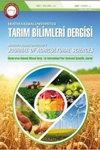Density and Biomass of Fish Populations in Kirmir Stream of Sakarya River, Turkey
IF 1.1
4区 农林科学
Tarim Bilimleri Dergisi-journal of Agricultural Sciences
Pub Date : 2016-08-25
DOI:10.1501/TARIMBIL_0000001400
引用次数: 2
Abstract
Bu calismada, Ic Anadolu Bolgesi’ndeki Sakarya Nehri’nin Kirmir Cayi’nda balik turlerinin yogunluk ve biyomas degerlerini tahmin etmek icin uc avli ayrilmaya dayali metot kullanilmistir. 1.5256 ha’lik alanda ornekleme yapilmis ve1. IntroductionA fish population is shaped by the geologic, chemical, physical, and biological factors within and surrounding the environment in which it lives. The relative quality of that environment affects the organisms living there, exerting positive or negative pressure on the population (Platts & McHenry 1988). The fluctuation of the fish population is really important for stock assessment and management. In this way, a major decline and rise in the population size or the population biomass can be detected, and appropriate management strategies can be adopted (Chen et al 2004). A relatively simple and inexpensive method of evaluating the health of lentic systems is to monitor the density and biomass of the fish population (Platts & McHenry 1988; Bohlin et al 1989).Density and biomass estimates of targeted species by electrofishing capture data are most often generated using depletion (or sometimes referred to as removal) (Moran 1951; Zippin 1958; White et al 1982) or the mark-recapture method (Ricker 1975; Zubik & Fraley 1988). Because these methods are labour intensive, they have been recommended only when researchers require detailed knowledge of the target population. Typically, removal methods have been used in stream environments where fish capture is by electrofishing during two to four intensive sampling periods over a short time period (often within a day) (Kelso 1989)土耳其萨卡里亚河基尔米尔溪鱼类种群密度和生物量
Bu calismada、Ic安纳托里亚Bolgesi 'ndeki Sakarya河'nin Kirmir河'nda balik turlerinin yogunluk ve biyomas degerlerini tahmin etmek icin uc avli ayrilmaya dayali metot kullanilmistir。1.我喜欢一种anda或nekleme yapilmis。鱼类种群受其生存环境内外的地质、化学、物理和生物因素的影响。环境的相对质量影响着生活在那里的生物,对种群施加积极或消极的压力(Platts & McHenry 1988)。鱼类种群的波动对种群评估和管理非常重要。通过这种方式,可以检测到种群规模或种群生物量的大幅下降和上升,并可以采取适当的管理策略(Chen et al . 2004)。评估生态系统健康的一种相对简单和廉价的方法是监测鱼类种群的密度和生物量(Platts & McHenry 1988;Bohlin et al . 1989)。通过电钓捕获数据对目标物种的密度和生物量估计通常是利用枯竭(或有时称为清除)产生的(Moran 1951;Zippin 1958;White et al . 1982)或标记再现法(Ricker 1975;Zubik & Fraley 1988)。由于这些方法是劳动密集型的,因此只有当研究人员需要对目标人群有详细的了解时,才推荐使用这些方法。通常情况下,在以电钓法捕获鱼类的河流环境中,在短时间内(通常在一天内)进行2至4次密集采样期间使用清除方法(Kelso 1989)。
本文章由计算机程序翻译,如有差异,请以英文原文为准。
求助全文
约1分钟内获得全文
求助全文
来源期刊
CiteScore
1.40
自引率
0.00%
发文量
26
期刊介绍:
Journal of Agricultural Sciences (JAS) is an international, double-blind peer-reviewed, open-access journal, published by the Faculty of Agriculture, Ankara University. The journal invites original research papers containing new insight into any aspect of Agricultural Sciences that are not published or not being considered for publication elsewhere. Preliminary, confirmatory or inconclusive research, review articles, case and local studies and works presenting taxonomy will not be published.

 求助内容:
求助内容: 应助结果提醒方式:
应助结果提醒方式:


